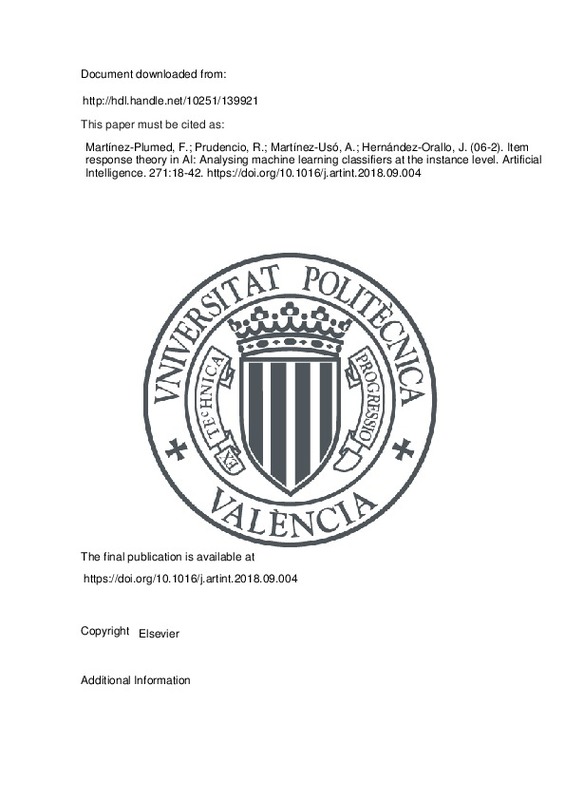JavaScript is disabled for your browser. Some features of this site may not work without it.
Buscar en RiuNet
Listar
Mi cuenta
Estadísticas
Ayuda RiuNet
Admin. UPV
Item response theory in AI: Analysing machine learning classifiers at the instance level
Mostrar el registro sencillo del ítem
Ficheros en el ítem
| dc.contributor.author | Martínez-Plumed, Fernando
|
es_ES |
| dc.contributor.author | Prudencio, Ricardo
|
es_ES |
| dc.contributor.author | Martínez-Usó, Adolfo
|
es_ES |
| dc.contributor.author | Hernández-Orallo, José
|
es_ES |
| dc.date.accessioned | 2020-04-01T07:15:09Z | |
| dc.date.available | 2020-04-01T07:15:09Z | |
| dc.date.issued | 2019-06 | es_ES |
| dc.identifier.issn | 0004-3702 | es_ES |
| dc.identifier.uri | http://hdl.handle.net/10251/139921 | |
| dc.description.abstract | [EN] AI systems are usually evaluated on a range of problem instances and compared to other AI systems that use different strategies. These instances are rarely independent. Machine learning, and supervised learning in particular, is a very good example of this. Given a machine learning model, its behaviour for a single instance cannot be understood in isolation but rather in relation to the rest of the data distribution or dataset. In a dual way, the results of one machine learning model for an instance can be analysed in comparison to other models. While this analysis is relative to a population or distribution of models, it can give much more insight than an isolated analysis. Item response theory (IRT) combines this duality between items and respondents to extract latent variables of the items (such as discrimination or difficulty) and the respondents (such as ability). IRT can be adapted to the analysis of machine learning experiments (and by extension to any other artificial intelligence experiments). In this paper, we see that IRT suits classification tasks perfectly, where instances correspond to items and classifiers correspond to respondents. We perform a series of experiments with a range of datasets and classification methods to fully understand what the IRT parameters such as discrimination, difficulty and guessing mean for classification instances (and their relation to instance hardness measures) and how the estimated classifier ability can be used to compare classifier performance in a different way through classifier characteristic curves. | es_ES |
| dc.description.sponsorship | This work has been partially supported by the EU (FEDER) and the Ministerio de Economia y Competitividad (MINECO) in Spain grant TIN2015-69175-C4-1-R, the Air Force Office of Scientific Research under award number FA9550-17-1-0287, and the REFRAME project, granted by the European Coordinated Research on Long-term Challenges in Information and Communication Sciences Technologies ERA-Net (CHIST-ERA) and funded by Ministerio de Economia y Competitividad (MINECO) in Spain (PCIN-2013-037), and by Generalitat Valenciana PROMETEOII/2015/013. Fernando Martinez-Plumed was also supported by INCIBE (INCIBEI-2015-27345) "Ayudas para la excelencia de los equipos de investigacion avanzada en ciberseguridad", the European Commission (Joint Research Centre) HUMAINT project (Expert Contract CT-EX2018D335821-101), and Universitat Politecnica de Valencia (PAID-06-18 Ref. SP20180210). Ricardo Prudencio was financially supported by CNPq (Brazilian Agency). Jose Hernandez-Orallo was supported by a Salvador de Madariaga grant (PRX17/00467) from the Spanish MECD for a research stay at the Leverhulme Centre for the Future of Intelligence (CFI), Cambridge, a BEST grant (BEST/2017/045) from the Valencia GVA for another research stay also at the CFI, and an FLI grant RFP2. | es_ES |
| dc.language | Inglés | es_ES |
| dc.publisher | Elsevier | es_ES |
| dc.relation.ispartof | Artificial Intelligence | es_ES |
| dc.rights | Reserva de todos los derechos | es_ES |
| dc.subject | Artificial intelligence evaluation | es_ES |
| dc.subject | Item response theory | es_ES |
| dc.subject | Machine learning | es_ES |
| dc.subject | Instance hardness | es_ES |
| dc.subject | Classifier metrics | es_ES |
| dc.subject.classification | LENGUAJES Y SISTEMAS INFORMATICOS | es_ES |
| dc.title | Item response theory in AI: Analysing machine learning classifiers at the instance level | es_ES |
| dc.type | Artículo | es_ES |
| dc.identifier.doi | 10.1016/j.artint.2018.09.004 | es_ES |
| dc.relation.projectID | info:eu-repo/grantAgreement/MECD//PRX17%2F00467/ | es_ES |
| dc.relation.projectID | info:eu-repo/grantAgreement/GVA//BEST%2F2017%2F045/ | es_ES |
| dc.relation.projectID | info:eu-repo/grantAgreement/JRC//CT-EX2018D335821-101/ | es_ES |
| dc.relation.projectID | info:eu-repo/grantAgreement/UPV//PAID-06-18-SP20180210/ | es_ES |
| dc.relation.projectID | info:eu-repo/grantAgreement/AFOSR//FA9550-17-1-0287/ | es_ES |
| dc.relation.projectID | info:eu-repo/grantAgreement/MINECO//PCIN-2013-037/ES/RETHINKING THE ESSENCE, FLEXIBILITY AND REUSABILITY OF ADVANCED MODEL EXPLOITATION/ | es_ES |
| dc.relation.projectID | info:eu-repo/grantAgreement/GVA//PROMETEOII%2F2015%2F013/ES/SmartLogic: Logic Technologies for Software Security and Performance/ | es_ES |
| dc.relation.projectID | info:eu-repo/grantAgreement/MINECO//TIN2015-69175-C4-1-R/ES/SOLUCIONES EFECTIVAS BASADAS EN LA LOGICA/ | es_ES |
| dc.relation.projectID | info:eu-repo/grantAgreement/INCIBE//INCIBEI-2015-27345/ | es_ES |
| dc.rights.accessRights | Abierto | es_ES |
| dc.contributor.affiliation | Universitat Politècnica de València. Departamento de Sistemas Informáticos y Computación - Departament de Sistemes Informàtics i Computació | es_ES |
| dc.description.bibliographicCitation | Martínez-Plumed, F.; Prudencio, R.; Martínez-Usó, A.; Hernández-Orallo, J. (2019). Item response theory in AI: Analysing machine learning classifiers at the instance level. Artificial Intelligence. 271:18-42. https://doi.org/10.1016/j.artint.2018.09.004 | es_ES |
| dc.description.accrualMethod | S | es_ES |
| dc.relation.publisherversion | https://doi.org/10.1016/j.artint.2018.09.004 | es_ES |
| dc.description.upvformatpinicio | 18 | es_ES |
| dc.description.upvformatpfin | 42 | es_ES |
| dc.type.version | info:eu-repo/semantics/publishedVersion | es_ES |
| dc.description.volume | 271 | es_ES |
| dc.relation.pasarela | S\406530 | es_ES |
| dc.contributor.funder | Generalitat Valenciana | es_ES |
| dc.contributor.funder | Ministerio de Economía y Competitividad | es_ES |
| dc.contributor.funder | Universitat Politècnica de València | es_ES |
| dc.contributor.funder | Air Force Office of Scientific Research | es_ES |
| dc.contributor.funder | Ministerio de Educación, Cultura y Deporte | es_ES |
| dc.contributor.funder | Instituto Nacional de Ciberseguridad | es_ES |
| dc.contributor.funder | European Regional Development Fund | |
| dc.contributor.funder | Conselho Nacional de Desenvolvimento Científico e Tecnológico, Brasil | |
| dc.contributor.funder | Joint Research Centre | es_ES |







![[Cerrado]](/themes/UPV/images/candado.png)

